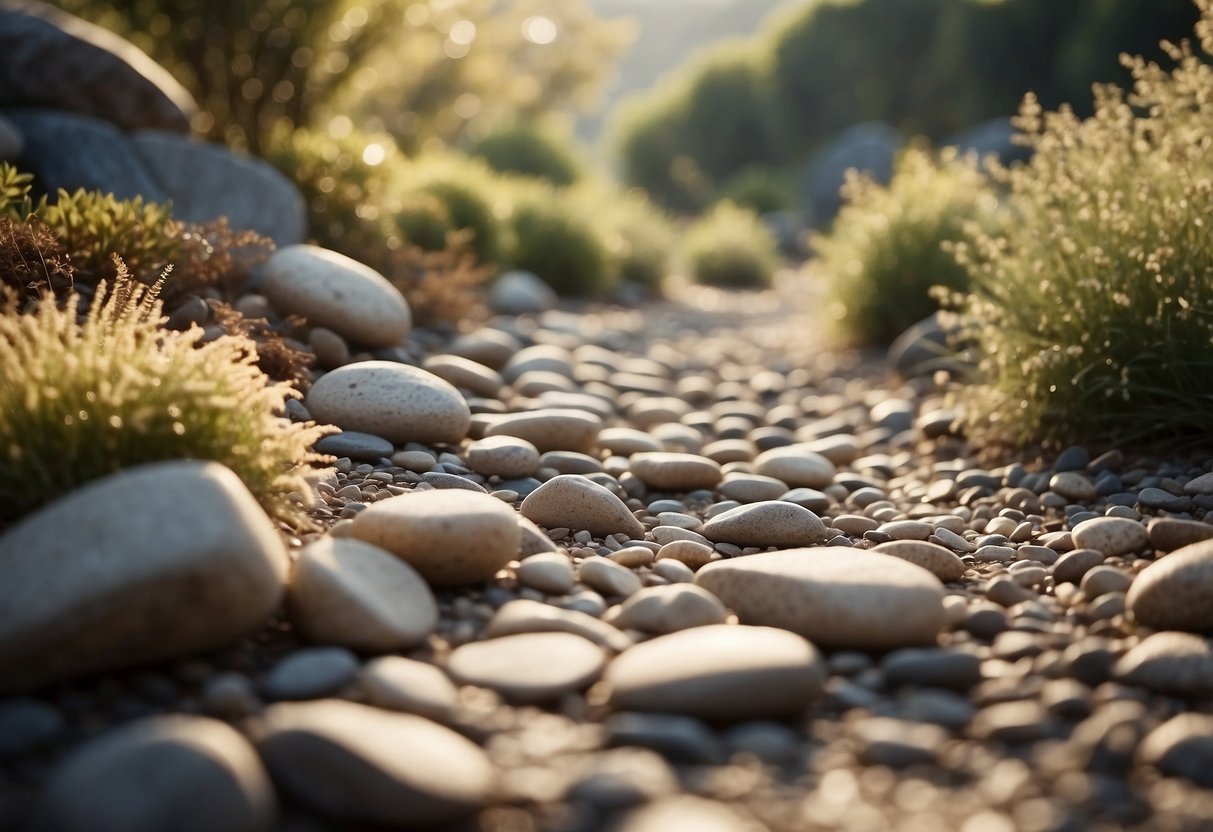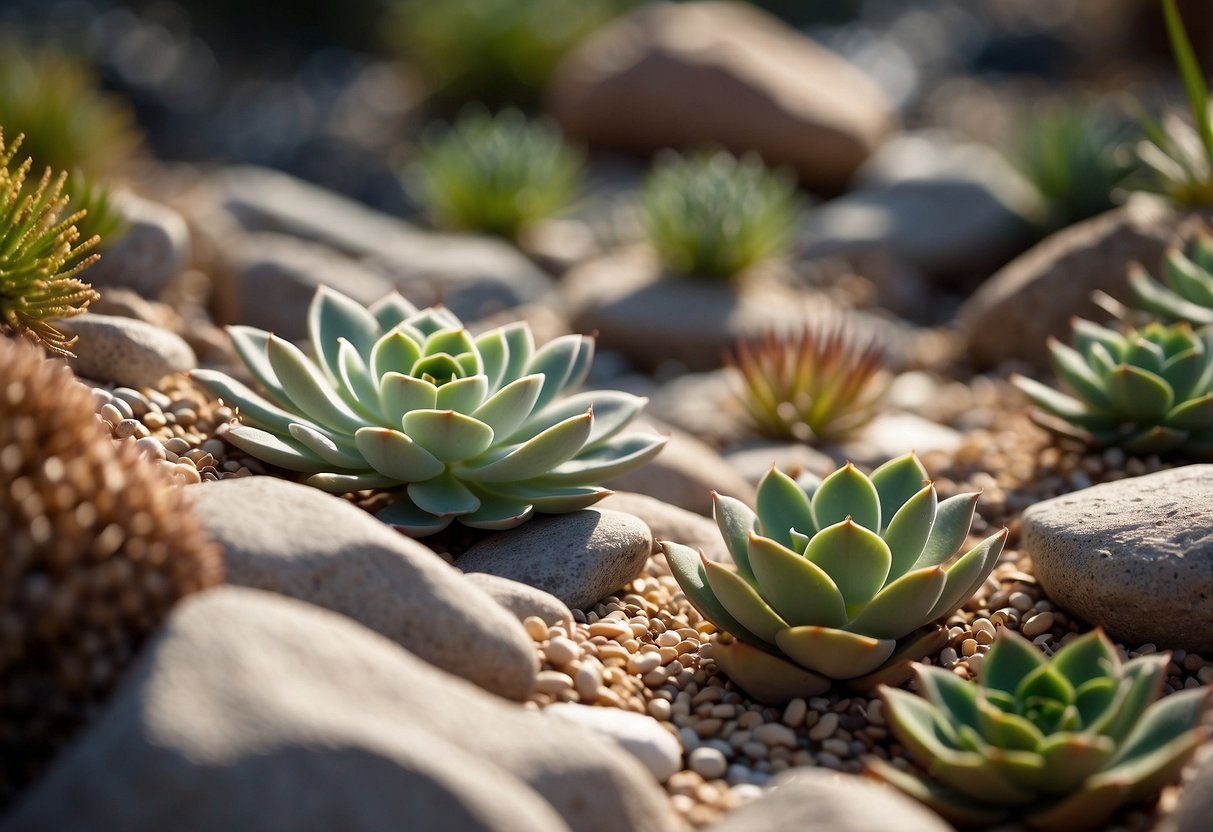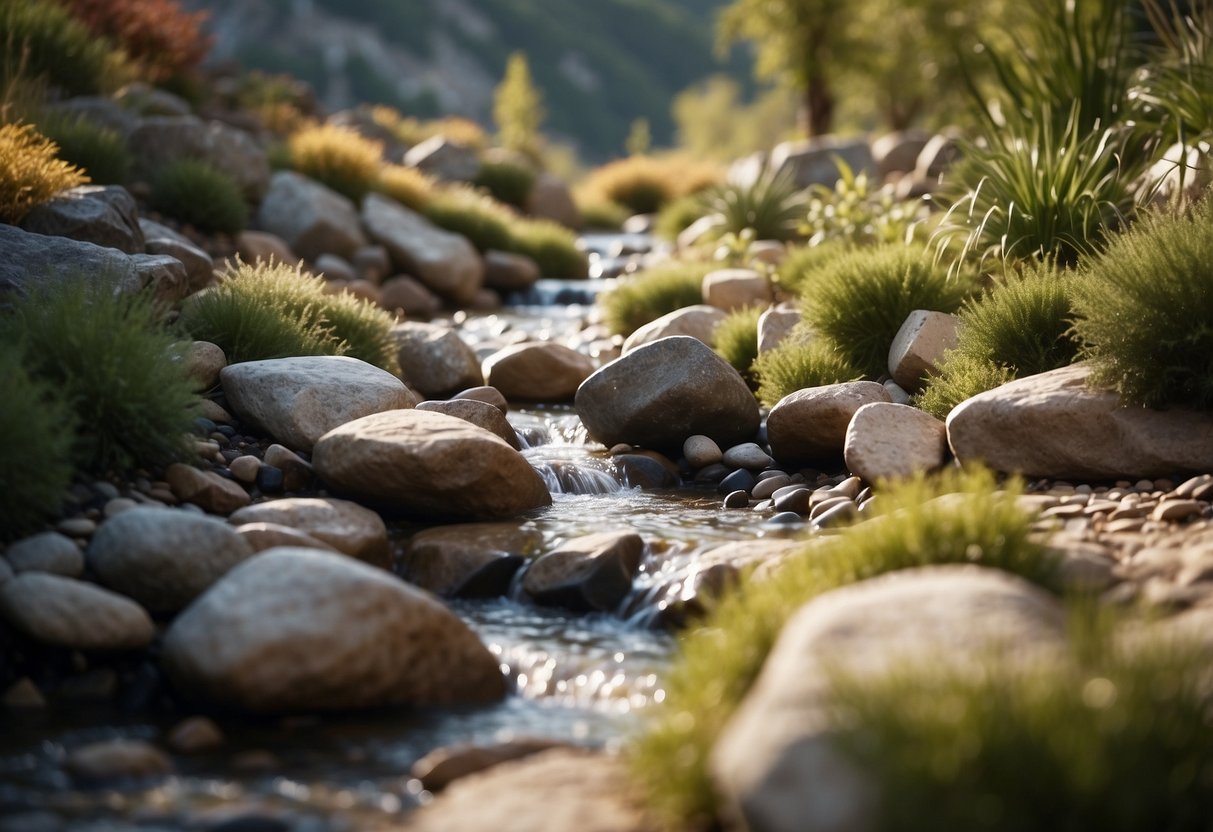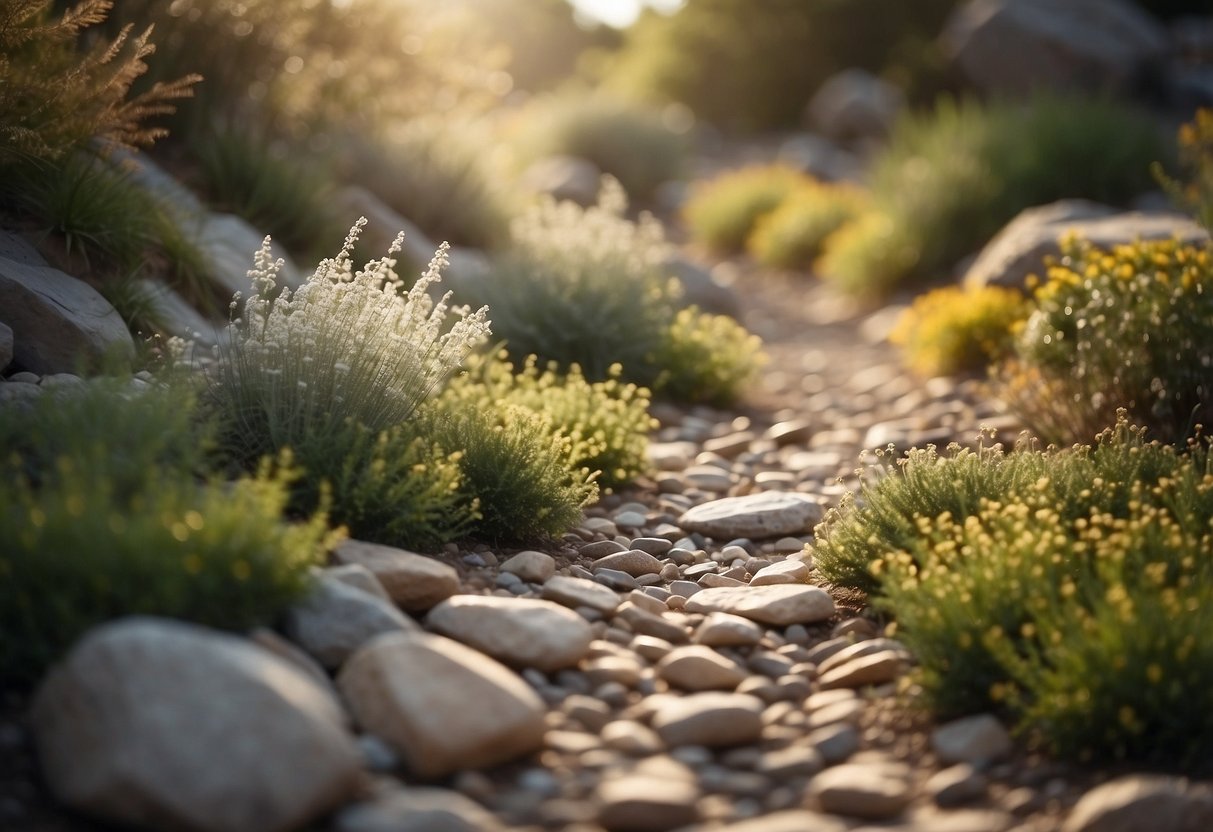Dry River Bed Rock Garden Ideas: Transform Your Yard into a Serene Oasis
Creating a dry river bed rock garden is a fantastic way to add a unique and natural touch to your yard. By mimicking the look of a dried-up river or creek, these gardens can provide both aesthetic charm and practical benefits like improved drainage. This landscaping choice blends well with various garden styles, adding texture and visual interest.

What are some easy and creative dry river bed rock garden ideas you can try in your yard? In this article, you’ll explore a mix of design tips and suggestions that can transform your outdoor space into a beautiful and low-maintenance sanctuary. Whether you have a large garden or a small backyard, you’ll find inspiration to suit your needs.
1) River Rock Stream

To create a beautiful river rock stream in your garden, start by choosing a variety of river rocks. Use rocks of different sizes, from 2 to 8 inches in length, to give a natural look.
Place flat slate stones along the edges to form the borders. Fill the center with round rocks for a harmonious flow.
Lay landscaping fabric underneath the rocks to prevent weeds. Add some river rock along the edges for a polished touch. Consider the rock’s color to match your garden’s style. Keep the layout gentle and fluid for a realistic stream appearance.
2) Zen Stone Pathway

Creating a Zen stone pathway brings peace and beauty to your dry river bed rock garden. Use smooth, flat stones to form a curving path that encourages a mindful stroll.
Surround the pathway with small river rocks and moss to enhance the calming effect. The combination of textures will make your garden a soothing retreat. Find more ideas here.
3) Succulent Rockery

You can add succulents to your dry river bed to create a unique rockery. Succulents come in various shapes and colors, adding vibrancy to your garden.
To create height, stack some flat rocks. This makes low-growing succulents stand out more.
Use rocks you find on hikes for a natural feel. This can make your garden look rustic and inviting succulent rock garden ideas.
4) Boulder Steps

Boulder steps can add a natural, rugged look to your dry river bed rock garden. Use large, flat boulders to create steps.
Place the boulders securely to ensure they are stable. Arrange them in a way that looks natural and flows with your garden’s design.
Make sure each step is even and comfortable to walk on. Adding boulder steps can make your garden both beautiful and functional. For more ideas, visit this guide.
5) Driftwood Decor

Adding driftwood to your dry river bed rock garden brings a natural, rustic touch. Place pieces of driftwood among the rocks to create contrast and interest.
Use different sizes of driftwood to enhance the look. Smaller pieces can sit on the edges while larger ones can be focal points.
Driftwood can also serve as a natural border within your garden, defining spaces elegantly.
6) Pebble Mosaic

Unleash your creativity with a pebble mosaic in your dry river bed. Arrange pebbles of different colors and sizes to form unique patterns or images. This can be a fun project that adds a personal touch to your garden.
A well-designed pebble mosaic can turn your garden into an eye-catching art piece. Use bright and contrasting colors to make your design stand out. Adding a pebble mosaic to your yard can impress visitors and enhance your garden’s natural beauty. Check out these ideas for inspiration.
7) Terraced Rock Beds

Terraced rock beds add a dynamic, multi-level look to your garden. By arranging rocks and soil in tiers, you can create a series of small, flat areas that look like natural steps.
These terraced beds help with drainage and give plants the perfect place to thrive. Mix different sizes of rocks and pebbles to add texture and interest throughout your garden.
Incorporate some greenery on each level to soften the look and make it more inviting. This way, you get a lovely blend of rocks and plants spread over multiple levels.
8) Rocky Waterfall Feature

Transform your dry river bed into a beautiful rocky waterfall feature. Use different sizes of rocks and stones to create the illusion of water cascading down a slope.
You can add some small plants or moss between the stones to give it a more natural look. This feature not only adds beauty but also a calming sound to your garden. For more ideas, visit DigsDigs.
9) Gravel Garden Path

Creating a gravel garden path can add a rustic charm to your yard. You can use materials like pea gravel, river rock, or crushed stone.
First, determine the path’s shape and mark it with stakes and string. Dig out the area about 4-6 inches deep.
Lay down landscape fabric to prevent weeds, then fill the path with gravel. Smooth and compact the gravel to finish. This simple addition can create a beautiful, low-maintenance path in your garden.
10) Miniature Stone Pagoda

Add a miniature stone pagoda to your dry river bed rock garden for a special touch. These small structures bring a sense of calm and traditional beauty. Place your pagoda on a flat rock or among smaller stones to highlight its features.
Pair it with lush greenery and vibrant flowers for extra charm.
Benefits of a Dry River Bed Rock Garden

A dry river bed rock garden offers several advantages including enhanced visual appeal, easy maintenance, and positive environmental impact. These key benefits can transform your garden into a beautiful and functional space.
Enhanced Aesthetic Appeal
A dry river bed adds a unique visual element to your garden. It mimics the look of a natural watercourse.
Using a mix of big rocks, smaller pebbles, and some plants creates a striking appearance. You can design specific patterns or layouts that fit your garden’s style and size.
Incorporating natural materials like rocks and pebbles gives the garden a more authentic look. Adding some greenery along the edges can further enhance its appeal. With careful planning, your garden becomes not only a place for relaxation but also a visual treat.
Low Maintenance Landscaping
A dry river bed rock garden requires less upkeep compared to other garden types. There’s minimal need for regular watering since it doesn’t rely on grass or thirsty plants.
Rocks and pebbles don’t need frequent care. They can stand up to harsh weather without much effort on your part. Using drought-tolerant plants keeps the garden looking good with little maintenance.
This setup is perfect if you have a busy schedule but still want a nice garden. You spend less time on upkeep, giving you more time to enjoy your beautiful outdoor space.
Environmental Advantages
Dry river bed gardens help conserve water. They don’t need irrigation like traditional lawns. This makes them an eco-friendly choice in areas with water restrictions.
These gardens also help with drainage and reduce soil erosion. The rocks and pebbles redirect rainwater, preventing it from pooling and causing damage.
By choosing local materials and native plants, you support local ecosystems. You create a habitat beneficial for wildlife like birds and insects. Choosing a dry river bed garden can make your yard more sustainable and environmentally friendly.
Creating a beautiful, low-maintenance, and eco-friendly space has never been easier. Embrace the benefits of a dry river bed rock garden for a stunning and practical outdoor oasis.
Design Principles for Dry River Bed Rock Gardens

Creating a dry river bed rock garden involves careful selection of rocks, adding appropriate plant life, and designing the layout to mimic natural water flow. These principles help in achieving a realistic and eye-catching garden feature.
Choosing the Right Rocks
Choosing the right rocks is essential for creating a natural look. Use a mix of sizes, including large boulders, medium-sized rocks, and small pebbles. Larger rocks should define the borders while smaller pebbles and stones fill in the gaps.
Color and texture matter too. Natural-looking stones with earthy tones blend well with the landscape. Avoid bright or artificial colors that can look out of place. Opt for rounded stones to mimic the softness of water-worn rocks.
Placement is key. Arrange rocks in a flowing pattern, with larger stones anchoring the design and smaller ones scattered around them. A mix of textures—smooth river rocks and rough-edged stones—adds visual interest and realism.
Incorporating Plant Life
Adding plant life to a dry river bed rock garden brings it to life. Use a variety of plants to create a lush, inviting space. Native grasses, succulents, and small shrubs are great choices because they are low-maintenance and drought-resistant.
Place plants strategically. Groupings of plants can soften the harsh lines of rocks and create a more natural look. Use taller plants as background features and shorter ones closer to the “river” bed.
Color and texture are also crucial. Mix different shades of green, along with flowering plants for pops of color. Choose plants with varying textures to add depth and dimension. Mulch around plants helps retain moisture and reduces the need for frequent watering.
Creating Natural-Looking Water Flow
Designing a dry river bed that looks like it once flowed with water requires an understanding of natural water patterns. Start with a winding path that mimics how rivers naturally curve and bend. Straight lines can look artificial and less appealing.
Gradual slopes and slight elevations enhance realism. Digging deeper in certain sections and shallower in others creates the illusion of depth and movement. Use larger rocks at bends and straights to suggest the force of water shaping the landscape.
Finally, add small pools or depressions to break the monotony and provide visual interest. These can be decorated with pebbles and small plants that thrive in rocky environments. This not only adds to the aesthetics but also supports local wildlife.







